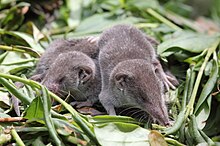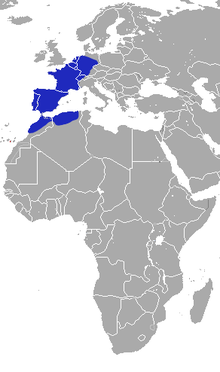| Greater white-toothed shrew[1] | |
|---|---|

| |
| Scientific classification | |
| Domain: | Eukaryota |
| Kingdom: | Animalia |
| Phylum: | Chordata |
| Class: | Mammalia |
| Order: | Eulipotyphla |
| Family: | Soricidae |
| Genus: | Crocidura |
| Species: | C. russula
|
| Binomial name | |
| Crocidura russula (Hermann, 1780)
| |

| |
| Greater white-toothed shrew range | |
The greater white-toothed shrew (Crocidura russula) is a small insectivorous mammal[3] found in Europe and North Africa.
It is the most common of the white-toothed shrews. This species is found along the Mediterranean, Netherlands, Belgium, Ireland, Germany and Portugal;[4] in addition, the Osorio shrew of the Canary island of Gran Canaria, originally described as a separate species (Crocidura osorio), was later discovered to be a population of introduced greater white-toothed shrew.[5] Furthermore, a subspecies of the greater white-toothed shrew, Crocidura russula ibicensis, is found on the Mediterranean island of Ibiza.[6] In April 2008, the greater white-toothed shrew was discovered in Ireland as well. Its preferred habitats are grassland and woodland. It is slightly larger than the lesser white-toothed shrew but otherwise very similar and can often be distinguished only by close inspection of its teeth which are unpigmented.[7]
- ^ Hutterer, R. (2005). Wilson, D.E.; Reeder, D.M. (eds.). Mammal Species of the World: A Taxonomic and Geographic Reference (3rd ed.). Johns Hopkins University Press. p. 248. ISBN 978-0-8018-8221-0. OCLC 62265494.
- ^ Aulagnier, S.; Hutterer, R.; Amori, G.; Kryštufek, B.; Yigit, N.; Mitsainas, G.; Palomo, L. (2021) [amended version of 2016 assessment]. "Crocidura russula". IUCN Red List of Threatened Species. 2021: e.T29652A197503499. doi:10.2305/IUCN.UK.2021-1.RLTS.T29652A197503499.en. Retrieved 23 April 2021.
- ^ Duarte, L.C.; Bouteiller, C; Fontanillas, IP; Petit, E; Perrin, N (2003). "Inbreeding in the Greater White-Toothed Shrew, Crocidura russula" (PDF). Evolution; International Journal of Organic Evolution. 57 (3): 638–45. doi:10.1554/0014-3820(2003)057[0638:iitgws]2.0.co;2. JSTOR 3094775. PMID 12703953. S2CID 198155850.
- ^ David R Stone (1995). "Eurasian Insectivores and Tree Shrews- Status Survey and Conservation Action Plan". Archived from the original on 2014-12-26. Retrieved 2011-11-28.
- ^ Molina, O. et al. (2003) "The origin of the Osorian shrew (Crocidura osorio) from Gran Canaria resolved using mtDNA". Italian Journal of Zoology, Volume 70, Issue 2
- ^ Antoni Alcover, J., ed. (1988). "Mamífers Actuals". els Mamífers de les Balears. Palma de Mallorca: Editorial Moll. pp. 85–87. ISBN 84-273-0265-7.
- ^ Nowak, Ronald, M. (1999). Walker's Mammals of the World. The Johns Hopkins University Press. ISBN 978-0-8018-5789-8.
{{cite book}}: CS1 maint: multiple names: authors list (link)
